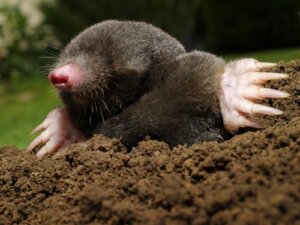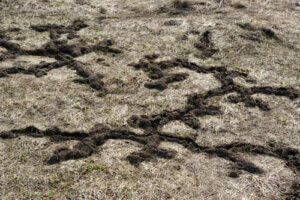Mole Facts & Information
Everything you need to know about moles
what do moles look like

Moles typically have rounded, furry bodies. While most of their bodies are covered with black to gray fur, they have prominent, hairless snouts that extend nearly a half-inch in front of their mouths. Other identifying features are their hairless front claws that are oversized in relation to the rest of their bodies. These large, spiky appendages help moles effortlessly cut through and move significant amounts of soil. Since they spend so much time underground, their eyes are extremely small and concealed in fur to keep out dirt. Their #1 food source for moles is earthworms, which make up about 90% of their diet followed by grubs. Moles find their meal by feeling the vibration of the earthworm moving through the soil.Not the rodent you have?
How Did I Get Moles
Moles are attracted to the food sources in your yard, digging through leaving behind tunnels, holes, and mounds of dirt. Moles require quite a bit of food to survive and if your yard has it, they will be there. Common signs of moles include surface tunnels, dying grass and plants, an increase in weeds, and molehills (which are piles of dirt less than 6 inches tall and shaped like footballs or volcanoes). Unlike ants that are attracted to sugary spills that can be cleaned up, it’s really nothing you’re doing that is attracting the moles. Rich soil is a good thing for your lawn, but unfortunately it also means earthworms – mole’s primary food source.
How Do I Get Rid of Moles
Getting rid of moles can be difficult since not only does both your yard and garden have what attracts them (earthworms), you often don’t know you have them until the tell-tale signs. Often, DIY mole control isn’t always effective. Most over-the-counter mole control products will move them along … to another part of your yard. The only way to really get rid of moles is to bring in a professional mole removal company. The products and treatment strategies they use are effective – but should be left in professional hands.
Where Do Moles Live?

These pests are known for digging intricate underground tunnels, using them as passageways for travel and as nests. The mole can live virtually anywhere with diggable soil, including grasslands, yards, lawns, sand dunes, and gardens. In fact, their preference for soil that is shaded, cool, moist, and populated by worms and grubs accounts for their attraction to lawns and parks. Moles are commonly thought to look like meadow mice, shrews, and pocket gophers. They are generally more active in late winter and early spring when mole breeding is at its peak. However, moles do not hibernate, they remain active all year long and are very territorial.
Problems Caused by Moles
Unfortunately, when moles are making tunnels, they are also destroying someone’s yard. If they don’t burrow deep enough, they create unsightly ridges wherever they have been digging, which also kills grass. This tunneling behavior weakens the ground, creating uneven surfaces and trip hazards. Yard equipment can also become stuck and damaged in these depressions. Moles can dig up to 18 feet per hour. As they dig, they detach the roots of plants which not only allows weeds to take root but also kills the lawn, plants, and trees. That damage makes people call a professional for mole pest control services.
How Do I Prevent Moles
Moles feed on grubs and earthworms. If you take steps to eliminate their food source, the moles will look elsewhere. If you want to keep moles out of a specific area, like a garden bed, create a trench around the perimeter. Dig a trench about three feet deep and fill it with rocks or wire mesh extending to the bottom of the trench. DIY mole control methods often don’t work and will just make them turn to another section of your lawn. That’s when you should call in a mole exterminator for professional mole control treatments.
WHY OPC FOR MOLE CONTROL
We’re passionate about controlling moles because we live and work here – it’s our neighborhood, too. We’ve been keeping homes and businesses in Kentucky, Indiana, and portions of Ohio safe from pests since 1972. OPC Pest Services has the experience you can trust.
Expert pest control since 1972
Quality Pro certified company
Satisfaction guarantee.
Need help with moles?
GET A QUOTE
“We’ve used OPC for over 16 years for termites, moles, and 4 seasons pest control and just added rodent control stations since a family of rats moved under our deck. They are professional, knowledgeable and reliable at a fair price.”
Louisville, KY